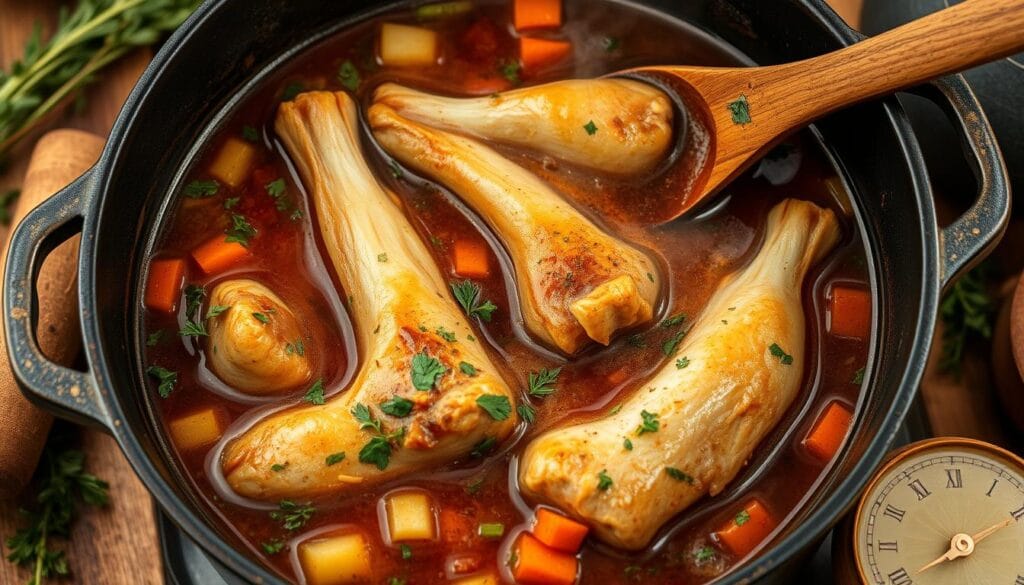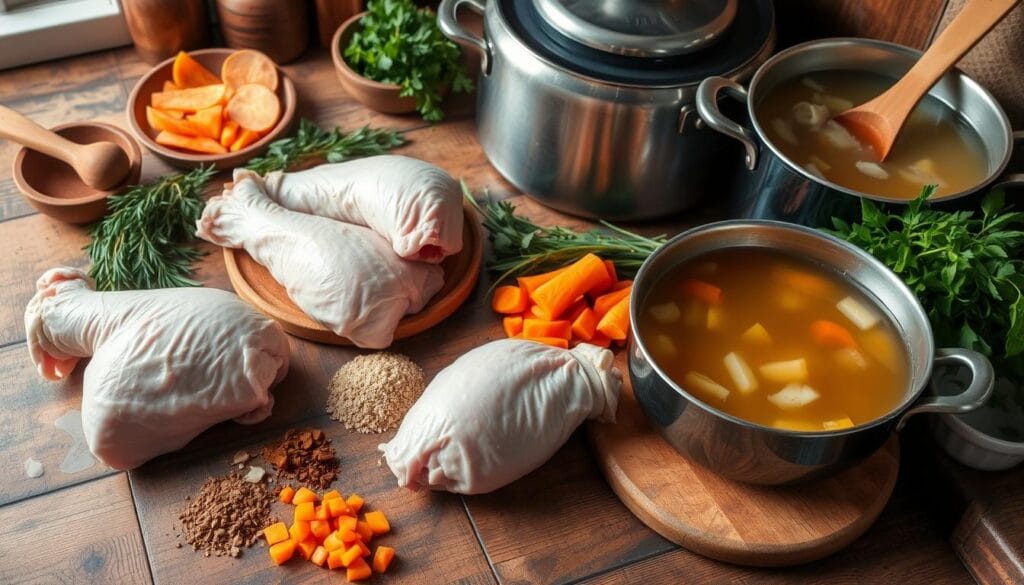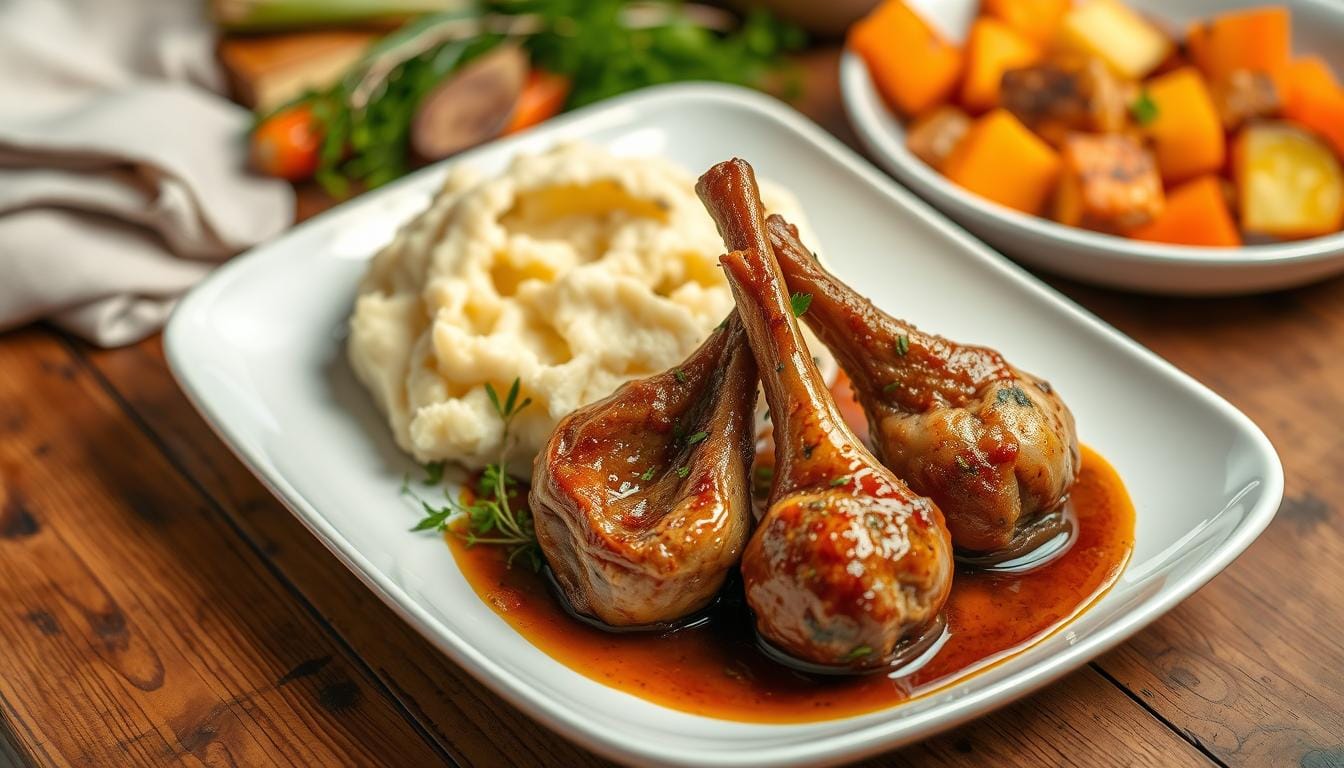Every kitchen has a hidden gem waiting to be discovered. For me, that treasure is the turkey neck. Growing up, my family used every part of the ingredient. We believed in making the most of what we had.
A turkey neck recipe is more than just cooking. It’s about making a dish that’s both affordable and full of nutrients. These cuts are packed with protein, iron, and B vitamins. They offer up to 50 grams of protein per serving.
Whether you’re making a turkey neck stew or slow-cooking, this guide will change how you see this ingredient. You’ll discover flavors that will amaze your taste buds.
Table of Contents
Understanding Turkey Necks and Their Culinary Potential
Turkey necks are a hidden gem in cooking. They add rich flavors and offer great nutrition. These often-overlooked cuts can make your meals better.
Exploring turkey neck meat reveals many nutritional benefits. A 4-ounce serving has a great nutritional profile. It supports health and tastes great.
What Makes Turkey Necks Special
Smoked turkey necks are special for several reasons:
- They have a deep, rich flavor.
- Their meat is dense and tender.
- They are high in protein.
- They are also a budget-friendly protein option.
Benefits of Cooking with Turkey Necks
Turkey neck meat is packed with nutrients. Here are some highlights:
| Nutrient | Amount per 4 oz |
|---|---|
| Calories | 398 |
| Protein | 50g |
| Fat | 18g |
| Iron | 3.2mg |
Selection and Preparation Tips
Choose fresh, high-quality smoked turkey necks. Pro tip: Marinate them for at least 3 hours. This makes them taste better and become more tender.
Use a mix of kosher salt, black pepper, garlic powder, and paprika for seasoning. It will make your dish even better.
“Turkey necks are not just meat—they’re a culinary canvas waiting to be transformed.”
You can cook turkey necks in many ways. Try slow cooking or braising. Keep the temperature between 325-375°F. Remember, slow cooking makes them tender and flavorful.
Essential Ingredients for Perfect Turkey Neck Recipe
Starting a delicious turkey neck dish means picking the right ingredients. Your journey begins with knowing how each part adds to the flavor of the gravy and broth.
- 2.5 pounds fresh turkey necks
- 3 tablespoons cooking oil
- 1 yellow onion, diced
- 2-3 garlic cloves, minced
- Celery stalks
- Carrots
- 32 oz chicken broth
- Seasonings: salt, pepper, paprika, thyme
- Bay leaves
| Ingredient | Quantity | Purpose |
|---|---|---|
| Turkey Necks | 2.5 pounds | Main protein source |
| Chicken Broth | 32 oz | Base for turkey neck broth |
| Cooking Oil | 3 tablespoons | Sautéing and browning |
The secret to amazing turkey neck gravy is in the flavors. Your herbs and spices turn simple ingredients into a hearty dish. Marinating the turkey necks for at least 3 hours makes the flavors deeper.
“Great cooking is about ingredients and how to prepare them.” – Wolfgang Puck
With the right ingredients, you’ll make a turkey neck recipe that’s unforgettable. It will warm and satisfy your guests.
Cooking Methods and Techniques

Preparing slow-cooked turkey necks needs skill and patience. Different cooking methods can turn these cuts into tasty dishes like turkey neck gumbo. Knowing the right techniques will help you make tender, delicious meals that wow your family and friends.
Slow Cooking Magic
Slow cooking is perfect for turkey necks, making the meat tender. Here’s how to do it:
- Set your slow cooker to low heat
- Cook for 6-8 hours to break down tough connective tissues
- Ensure internal temperature reaches 165°F (74°C)
Braising Fundamentals
Braising brings out rich flavors in turkey necks. The technique involves:
- Searing necks in a hot pan to develop a golden crust
- Adding liquid and vegetables
- Covering and cooking at low temperature
Temperature and Timing Guidelines
Precise temperature control is key for perfect turkey neck dishes. Consider these cooking methods:
| Cooking Method | Temperature | Cooking Time |
|---|---|---|
| Oven Roasting | 300°F | 2-3 hours |
| Stovetop Simmering | Low-Medium | 2 hours |
| Slow Cooker | Low | 6-8 hours |
Remember, patience is key when preparing slow-cooked turkey necks. Each method offers unique flavor profiles and textures for your turkey neck gumbo or other delightful dishes.
“The secret to tender turkey necks is low and slow cooking” – Southern Cooking Wisdom
Creating Rich Flavors and Textures

To make your turkey neck dishes better, mix herbs, spices, and veggies well. Start by learning how to mix flavors. This turns simple foods into unforgettable meals.
- Choose fresh herbs like thyme and parsley
- Use strong spices like paprika and black pepper
- Add veggies for depth and complexity
For turkey neck dumplings, try these:
- Sauté onions and celery first
- Start with a rich chicken stock base
- Add seasonings slowly while cooking
“Patience and precise seasoning are the keys to exceptional flavor.”
| Ingredient | Flavor Profile | Recommended Quantity |
|---|---|---|
| Thyme | Earthy, slightly minty | 1-2 teaspoons |
| Paprika | Warm, slightly sweet | 2 tablespoons |
| Black Pepper | Sharp, spicy | 1 teaspoon |
Your turkey neck dishes will stand out with the right flavor mix. Experiment with various herbs and spices to discover your preferred combination.
Conclusion
Your journey with turkey neck recipes is just starting. These cuts are incredibly versatile, offering endless possibilities in the kitchen. You’ve learned how to make them into tasty dishes, packed with over 100 grams of protein per serving.
Mastering turkey neck recipes takes time and practice. Whether you’re slow-cooking, baking, or smoking, each method brings out special flavors and textures. The secret is patience and knowing the right cooking techniques to make them tender and delicious.
Now, your kitchen is ready with tips on temperature, seasoning, and serving ideas. You can pair turkey necks with collard greens, mashed sweet potatoes, or creamy polenta. This makes your meals as good as those in a restaurant. Plus, turkey necks are great for muscle repair and provide essential minerals, making them a healthy choice.
We encourage you to try new things, explore, and enjoy turkey neck recipes. Share your dishes, learn from each try, and celebrate the tradition of turning this often-overlooked ingredient into a fantastic meal.
FAQ
What are turkey necks, and why are they worth cooking with?
Turkey necks are a tasty, affordable cut of meat. They’re full of protein and vitamins, making them a great choice for meals. Their tough parts become tender when cooked slowly, making them delicious.
What’s the best way to choose turkey necks for cooking?
Look for fresh, clean turkey necks without discoloration or bad smells. Buy from trusted butchers or stores. Free-range or organic options are best for flavor. Always check the meat’s freshness before buying.
What are the best ways to cook turkey necks?
Slow cooking and braising are top choices for turkey necks. These methods make the meat tender. Use slow cookers, Dutch ovens, or pressure cookers. Cooking times are 2-4 hours, depending on the recipe.
Are turkey necks nutritionally beneficial?
Yes, turkey necks are packed with protein, iron, zinc, and B-vitamins. They’re also rich in collagen, good for joints and skin. While they have fat, they’re nutritious when cooked healthily.
Can I use turkey necks in different types of cuisine?
Absolutely! Turkey necks are versatile and fit many cuisines. They’re great in Southern collard greens, Creole gumbo, stews, and broths. Their flavor works well in many cooking styles.
How should I store turkey necks before cooking?
Store raw turkey necks in the fridge for 1-2 days. Freeze them for 3-4 months if needed. Store them in airtight containers or freezer bags to maintain freshness.
What spices and herbs pair well with turkey necks?
Thyme, rosemary, bay leaves, garlic, paprika, and black pepper are great with turkey necks. Cajun and Creole seasonings also work well. For Southern dishes, try smoked paprika, cayenne, and onion powder.
Are there any tips for making turkey necks tender?
Low and slow cooking makes turkey necks tender. Use braising or slow cooking to break down the meat. Adding tomatoes or vinegar helps tenderize it. Cooking at 275-300°F for a long time is best.

